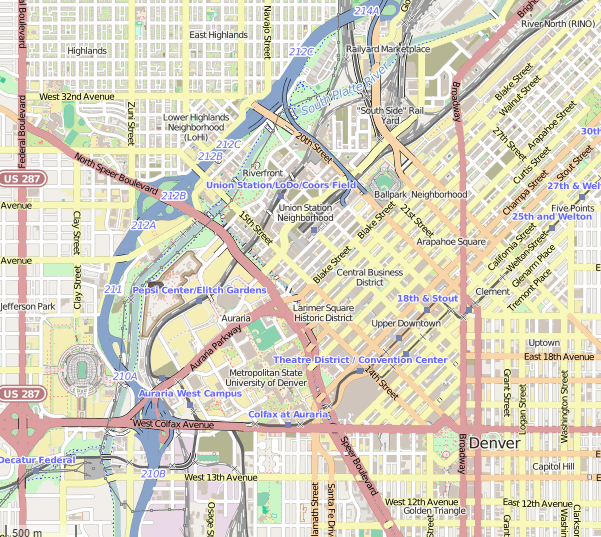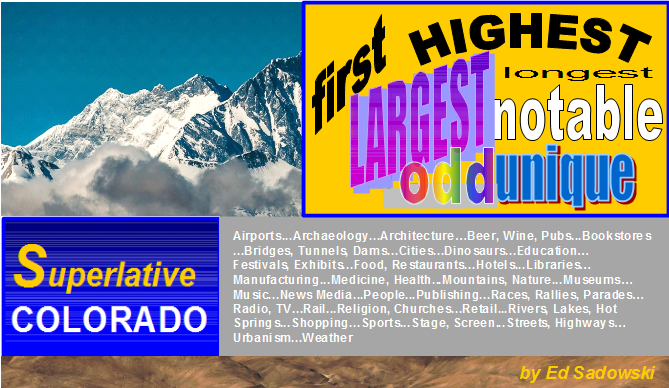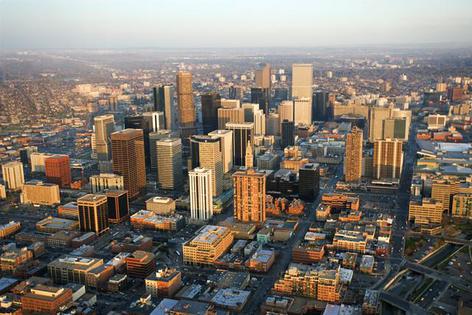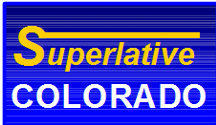Map: © OpenStreetMap contributors
Another Ed Sadowski creation
Urbanism
Airports...Archaeology...Architecture...Art...Beer, Wine, Pubs... Bookstores...Bridges, Tunnels, Dams...Churches, Religion... Cities... Dinosaurs... Education...Events, Festivals...Food, Restaurants..Hotels... Libraries... Manufaturing...Health, Medicine...Mountains, Nature... Museums... Music...News media...People...Publishing...Races, Rallies, Parades...Radio, TV...Rail transit...Retail...Rivers, Lakes, Hot Springs...Sports...Stage, Screen...Streets, Highways, Infrastructure... Urbanism...Weather, Climate
Downtown
Denver
URBANISM
16th Street Mall
Central Platte Valley
Downtown
Larimer Square
Lower Downtown Denver
16th Street Mall ////////////////////////////////////////////////
When most pedestrian malls have failed, the 16th Street Mall is one of the country’s most enduring and successful: also one of the longest at 1.42 miles (2.3 km) long, most of it pedestrian- and transit-only. The Mall stretches from Broadway Avenue to the Millennium Bridge (from which another two bridges connect pedestrians over railroad tracks and I-25 to Highland).
Designed by the renowned architect I.M. Pei, the Mall opened in 1982, and has been lauded by the Urban Land Institute. It is lined with over 150 restaurants, outdoor cafes, boutiques and retail centers Denver Pavilions and Tabor Center, and it runs one block from Larimer Square. It has over 200 trees, unique lighting fixtures and “carpet-runner” red, white and gray granite pavers resembling a rattlesnake’s back.
At one time 16th Street, the “main street of downtown,” with multiple department stores, was the city’s retail center before the advent of suburban shopping malls. It was this street that boasted the world’s largest Woolworth’s variety store, part of the Rocky Mountain region’s premiere shopping experience. While the street’s oldest retailers have moved away or gone out of business, a few remnants have stayed, such as the nation’s fourth oldest Walgreen’s, still at its same location since 1949.
Central Platte Valley ////////////////////////////////////////
The Central Platte Valley has become a thriving and inviting area, a late-blooming outgrowth of the west side of Union Station and LoDo. Its Commons district is bounded by Wewatta Street, I-25, Auraria Parkway, and 23rd Street. CPV actually consists of three neighborhoods: the more prominent Commons in the center, Prospect northward across from 23rd Street, and Auraria southward.
It all started as America’s largest undeveloped inner-city zone transformed spectacularly. Up to the 1990s, the Central Platte Valley, the historical heart of Denver located between the South Platte River and lower downtown, was the country’s largest undeveloped property adjacent to a major downtown.
The Central Platte Valley was set aside as an industrial area with some residential use when Denver’s streets were platted in the 1860s, an outgrowth from the birthplace of Denver in 1858 at the confluence of the South Platte and Cherry Creek.
By the 1950s the area had become a major rail yard, industrial and warehouse area. By the 1980s the decline in freight and passenger rail left the area in decay, with crumbling infrastructure, empty buildings, a wasteland of riverside dumping grounds and vagrants. Development of the 650 acres—almost twice the size of downtown—was severely hampered by complicated land ownership and intersecting rail lines.
The Central Platte Valley Comprehensive Plan of 1986 was created by community leaders, interest groups and the City and County of Denver as a blueprint for coordinated development of this huge area. The plan included considerations of land use, open space and bicycle– and pedestrian-friendly transportation.
Speculators had snapped up land in expectation of what was to come. The Bellingham, Washington-based Trillium Corporation bought 135 acres, and Denver billionaire railroad mogul Stephen Anschutz got control of 65 acres. Later, Avon, Colorado-based East West Partners came on board as a major player. Old viaducts have been replaced and several billion dollars of large-scale development have transformed the landscape into the urban gem it is today.
An unheard-of urban center development of a 90-acre ribbon of parks and green space is the centerpiece of CPV, complemented by the adjacent South Platte River Trail and Cherry Creek bikeways.
The South Platte has been revived for recreation, which includes the only urban spot with four whitewater rafting chutes. CPV is accented with the signature icon of the Millennium Bridge at the end of the 16th Street Mall, joining the Highland district across the I-25 Valley Highway with two additional pedestrian bridges, part of a distinctive trio of pedestrian bridges.
The area has seen a stupendous rebirth with the relocation of Elitch Gardens Amusement Park from North Denver, opening in CPV in 1995, now the Elitch Gardens Theme and Water Park, the only theme and water park in a downtown area. The world’s only architectural triple crown opening was in 1995 when Denver launched new ballpark (Coors Field), a new central library (Denver Public Library), a major airport (Denver International Airport), and within five weeks of each other, with a new downtown amusement park (Elitch’s) opening two months later.
Added adjacent to the South Platte River in 1999 has been one of country's top aquariums, now named the Downtown Aquarium, the largest aquarium between Chicago and California. In 1999 construction of the multi-purpose Pepsi Center sports arena was completed.
Subsequent developments have followed: several billions of dollars in completed and still-planned mixed-use residential, retail, and office projects anchored by the Confluence and Commons Parks along the now vibrant South Platte River.
CPV has succeeded as a carefully-crafted master-planned community, complementing and blending in with the adjacent lower downtown.
Residents can easily walk out their front door and jog, bike, picnic, rollerblade in the middle of a pleasant downtown environment. The South Platte is their backyard, where they can kayak and fish on, or simply relax and talk on a park bench.
Central Platte Valley -- Auraria
Superlatives: America's worst parking wasteland.
With the fabulous development of Central Platte Valley, America's largest raw, undeveloped inner-city area has shrunk considerably, but has not completely been rejuvenated. What remains of the previous underlying urban desert is a remaining section that takes the title of most vacuous sea of asphalt in America -- the more than 60 acres of parking lots in Central Platte Valley - Auraria.
In 2017 the CPV Auraria district was given the Golden Crater award by national readers of Streetsblog with good reason. The expansive area is across from LoDo and just north of the Auraria Campus, bound by I-25, Speer Boulevard and Auraria Parkway, a curious mixture of use and misuse and under-use. It is bisected with three light rail stations, whose huge destinations include the Pepsi Center and Elitch Gardens. But these stations are lone islands swallowed up by an endless sea of blacktop that serves no purpose other than car storage.
Of course this is not a permanent fate for the Auraria district. The vision for a pedestrian- and bike-friendly residential and business neighborhood is in motion with a recently amended plans by Denver to shape its development. The owners of the area have announced a comprehensive plan to develop it under the name of River Mile.
Downtown ///////////////////////////////////////////////////////
Downtown boundaries: I-25 on the north, Park, Grant and Broadway on the east, Speer on the west. Downtown neighborhoods (6): Auraria, Ballpark, Central Business District ("Commercial Core"), Central Platte Valley (Commons, Auraria and Prospect), Golden Triangle, LoDo
Center City neighborhoods: Capitol Hill, Five Points/Curtis Park, Highland, Jefferson Park, La Alma/Lincoln Park, Rino, Sun Valley, Uptown. (Map from Downtown Denver Partnership)
Downtown Denver, commensurate with the city as well as the state, has bounced back from the Great Recession with nationally top-ten rankings, unprecedented growth and expansion on many positive fronts: actual size of the downtown area and construction of office space, hotels, apartments, condos; growth in new businesses, residents, workers, visitors, conventions. The other side of the boom-town coin are the negatives, such as nationally-high lack of affordable housing and increases in homelessness. Some blame for the downsides goes to the paradoxical impact of rapid economic growth.
Some downtown Denver positive superlatives are as follows.
Size: Downtown Denver has joined the top-tier "one square-mile club" of central business districts with a size of 1.3 square mile (37.2M sq. ft.) of office space. This office space is actually larger than that of Washington, D.C., and getting close to the likes of top-ten Chicago and Detroit.
Employment: downtown's employment ratio to the metro is 11th in the nation (2006-10 US Census Bureau AMC Survey)
Bike friendly: 4th most bike-friendly downtown, 2017 (Forbes)
Number of mass transit use relative to the rest of the metro: Downtown mass transit users ratio to the metro are in or near the top 10 nationally in various categories, based on 2006-10 US Census Bureau AMC Survey data.
More specifically:
Central Business District (CBD) as a share of metro transit commuting: 9th
CBD transit commuting share to jobs: 12th
Metropolitan area and CBD transit commuting: 12th
CBD number of transit commuters: 12th
Downtown continues to ascend as one of the top convention destinations nationally:
Among the top 24 busiest convention places in terms of number of convention visits (2017, meetigsource.com)
Meeting destinations ranking in the US: 12th (2016, Cvent)
Larimer Square ////////////////////////////////////////////////
Larimer Street, between 14th and 15th, LoDo
Larimer Square, “Denver’s most historic block,” has been a national model and prototype for the revival of downtowns and urban revitalization.
Larimer Street was Denver’s first main street, but eventually became one of the country’s most infamous skid rows. It all changed after developer Dana Crawford and investors in 1965 stopped the block’s slated demolition, reversing the massive destruction of downtown buildings in the name of urban renewal.
The project has been recognized nationally as one of the first successful preservation projects of its kind. Crawford helped found Historic Denver, Inc., launching the preservation movement in Denver. The Larimer Square rebirth of restaurants and retail became the first project of a wave that turned Lower Downtown into a story of success that other cities have aspired to emulate.
Current Larimer Square tenants include The Comedy Works, named by USA Today as one of the top five comedy clubs in the nation.
Lower Downtown (LoDo) //////////////////////////////
LoDo is located in north central downtown, bounded by Cherry Creek and North Speer Boulevard to the west, Lawrence Street to the south, 20th Street to the east, and Wewatta Street to the north. "LoDo" (a takeoff on Manhattan's SoHo) was coined by The Denver Post columnist Dick Kreck in 1983.
Lower Downtown (LoDo) is Denver's oldest historic district, anchored by Union Station, an area that developed around the railroads of the new city, consisting of stores, hotels, saloons, bordellos, warehouses and mercantile buildings. The thoroughly run-down area was slated for demolition by the Denver Urban Renewal Authority (DURA) in the 1960s and 1970s. Preservationists put a halt to this action, but not until about 20 percent of the buildings had been demolished.
Today the 26-block district consists of 127 historic structures, one of the country's largest concentrations of Victorian and early twentieth-century buildings. Lower Downtown Denver has become a national model of how to save and transform a decaying core city neighborhood to a thriving residential, retail, and recreational district.
A LoDo zoning ordinance has placed limitations on building height and strict design guidelines for renovation and new construction.
The area full of old-world charm brick buildings has become trendy and gentrified, home to art galleries, brewpubs, sports bars, boutiques, and technology startups as well as home to several thousand residents in apartments and condos.
The historic Oxford Hotel, built in 1891, became a flophouse in the 1950s. During prohibition, the Oxford's Cruise Room operated as an illicit speakeasy, complete with secret paneling and underground tunnels, one of the country's few extant speakeasies.
In 1988 the Wynkoop Brewing Co. launched the craft brewing craze that has spread worldwide. In the 1990s LoDo had the highest number of microbreweries of any urban district.
New apartment and condo buildings have sprung up, as well as boutique hotels. The building of Colorado Rockies ballpark Coors Field in LoDo in 1995 was a major catalyst for the area's revival along with the 1999 addition of concert and sporting venue Pepsi Center.
LoDo has one of the greatest concentrations of sports bars of any city. The Blake Street Tavern, located near Coors Field, has won multiple awards and top ratings. In 2017 the establishment won an industry award as the best sports bar in America. The Tavern has 18,000 square feet, three bars, 60 televisions and a large game center.
In 2014, as a result of the LoDo Cares Initiatives, LoDo was recognized as the first Compassionate Neighborhood in the Charter for Compassion International’s Compassionate Community Campaign.



